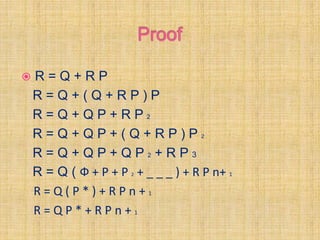Regular Grammar
- 1. Regular Grammar ( Theory of Computation)
- 2. A grammar is a 4-tuple G = (V,T,P,S) V: set of variables or nonterminals T: set of terminal symbols (terminals) P: set of productions S: a start symbol from V
- 3. V = { S }, T = { 0, 1 } Productions: S S 0S1 This grammar represents strings such as: 0011 000111 01
- 4. Leftmost derivation: the leftmost variable is always the one replaced when applying a production Rightmost derivation: rightmost variable is replaced
- 5. A tree in graph theory is a set of nodes such that › There is a special node called the root › Nodes can have zero or more child nodes › Nodes without children are called leaves › Interior nodes: nodes that are not leaves A parse tree for a grammar G is a tree such that the interior nodes are non-terminals in G and children of a non-terminal correspond to the body of a production in G
- 6. Yield: concatenation of leaves from left to right If the root of the tree is the start symbol, and all leaves are terminal symbols, then the yield is a string in L(G) Note: a derivation always corresponds to some parse tree
- 7. Regular Language – Regular Language are those languages which are accepted by finite automaton. Regular Expression – Regular Expression are used to denote Regular Languages. Regular Set – Any set that represent the value of Regular Expression.
- 8. In order to find out a regular expression of a finite automaton we use Arden's theorem. Statement 1 - Let P & Q be two regular expression. Statement 2 – If P doesn’t contain null string, then R = Q + R P ( has a unique solution) i.e. , R= Q P*
- 9. R = Q + R P R = Q + ( Q + R P ) P R = Q + Q P + R P 2 R = Q + Q P + ( Q + R P ) P 2 R = Q + Q P + Q P 2 + R P 3 R = Q ( Ф + P + P 2 + _ _ _ ) + R P n+ 1 R = Q ( P * ) + R P n + 1 R = Q P * + R P n + 1
- 10. Union of two regular language are always be regular. Intersection of two regular language are always be regular. Complement of two regular language are always be regular. Difference of two regular language are always be regular. Kleen closure operation over a regular language always be a regular.
- 11. Concatenation of two regular language are always be regular. Reverse of two regular language are always be regular.
- 12. Pumping Lemma is used as a proof for irregularity of a language. Thus, if a language is regular, it always satisfies pumping lemma. If there exists at least one string made from pumping which is not in L, then L is surely not regular.
- 13. The opposite of this may not always be true. That is, if Pumping Lemma holds, it does not mean that the language is regular.
- 14. It always consist of three variables i.e., x, y, I, z. Where, X can be null or can hold value y can not be null and has a value in it. I is the power upon y which increment by step . Z can be null or can hold value .
- 15. x y z Ф aa Ф wxyiz i>0 Ф(aa)iФ = (aa)I aaФL i=1 aaaФL i=2
















